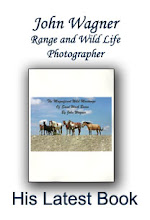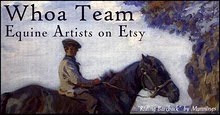Terri Nutter's Mustang "Dammit" was caught outside of an HMA so she doesnt know the exact Horse Management Area of origin. As best she can tell he was captured on the private land in an area bordering Conant Creek HMA in Wyoming.
 |
"Dammit"
5 by 5 inch Watercolor
by Linda L Martin Artist
SOLD
$35.00 |
One of the common misconception is that all mustangs managed by the Bureau of Land Management ( BLM) are on Federal lands. But in many cases the area of management is bordered or checker-boarded with privately owned lands. The horses of course don't know the difference. Sometimes they have to migrate through private lands to get to grazing or water.
Occasionally they stop and take up residence. Sometimes wild stallions will pick up domestic mares or domestic mares will join up with a herd passing through. This is one of the management issues that many people dont know about. The resulting foals can mean a huge financial liability for the rancher. Some ranchers even hire people to take the weaned wild foals from their domestic mares and train them and then either adopt them out or sell them. Because the foals aren't caught and branded by the BLM they are not as desirable as those who are completely wild and have the brand. This becomes a huge problem for the rancher.

The BLM must depend on good relationships with land owners and land associations in order to give the wild horses a free passage. When the horses become over populated on private land, the BLM must go in and remove the animals. This has led to a lot of confusion in past months. Especially in Wyoming where the herds have prospered so well on private lands that the Land Associations are demanding that the BLM do something to control the populations. This of course has caused a lot of controversy mostly because the average horse loving American who doesn't understand the nature of the problem.
The best I can explain it to those who are in the East is the issue of the white tailed deer population. In Virginia the populations in the last 30 years have bounced back by careful management to the point of nearing overpopulation and presenting hazards to travelers and financial losses to farmers. In communities where the animals historically lived that were once country sides with large working farms, the animals have become urbanized. Meaning as developments went in they live in gardens and feast off of peoples' flowering plants and back yard fruit trees in suburban neighborhoods and parks.
In the country, in Virginia, especially next to National Parks where there are no predators for deer, the animals come down out of the parks seeking food and found a feast of apples and other fruit from the apple growers. Deer don't just eat the fruit they eat the entire tree and this causes millions of dollars in damages each year.
The Fish and Game Department in Virginia will allow animals that are too dependent on human food sources to be shot with a special permit. They must be on the farmer's land and there is a limit as to how many can be shot per permit. The reason seems to be that there are so many deer, that to trap and release the trouble makers wont solve the problem. Since deer are migratory animals just like horses they would just find a new source in the new location. In this economy feeding wild animals, which is actually against the law in most states and on Federal land, could make or break someone who is trying to produce food to feed the nation.
The most difficult problem is that too many wild horses on private land uses up valuable resources that the ranchers need for their own live stock. This includes grazing and water but also feed in winter. In drought years this can be a disaster both for the animals and the financial stability of the rancher. Wild horses need space to roam in order to stay healthy but a farmer cannot take on the feeding of 100 or more wild horses and still be able to keep his fences in good repair or feed and cloth his family.
There is also the problem of dependency if a wild horse starts eating from the livestock stores on a regular basis.When a wild horse becomes dependent on feed from a rancher, they often associate them as the food source. Yet wild horses who are not afraid of humans, but have not learned respect can cause more than just damage from eating. They also have no limits around humans and can become dangerous and aggressive toward them just like any other wild animal, such as a deer or bear, once they associate food with humans.
The issue of wild horses is a complex one to say the least. The solution right now is rounding up a portion of the horses and allowing them to be adopted. Many other solutions are being discussed and tested through out the BLM managed lands.

In the Case of Dammit there was a happy ending when Terri adopted him. Having Dammit, has been a very positive experience. This wild horse is full of personality and smarts. Like many wild horses, he likes to play and he loves attention. In Terri's words " I don't know how I lived all these years with out a Mustang." His name might be Dammit but to Terri and her family this pretty boy is a blessing.




















































